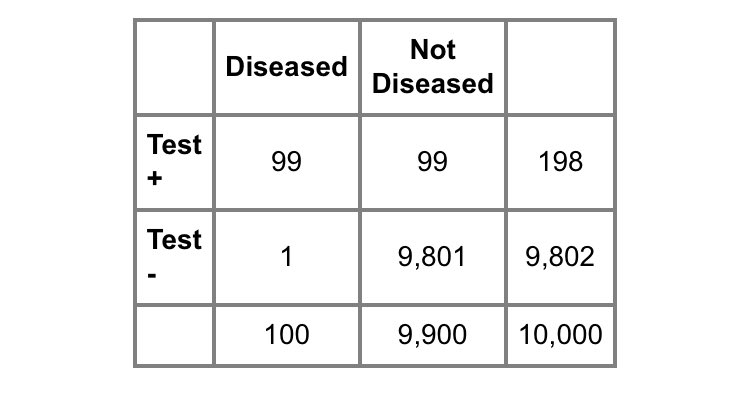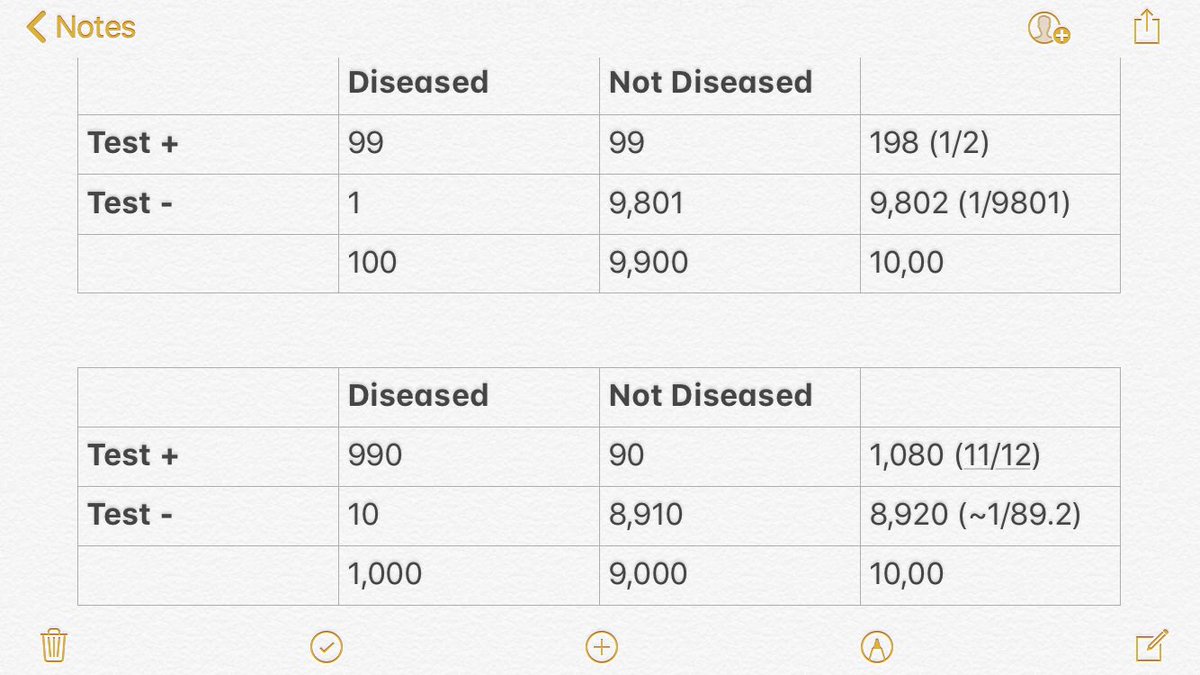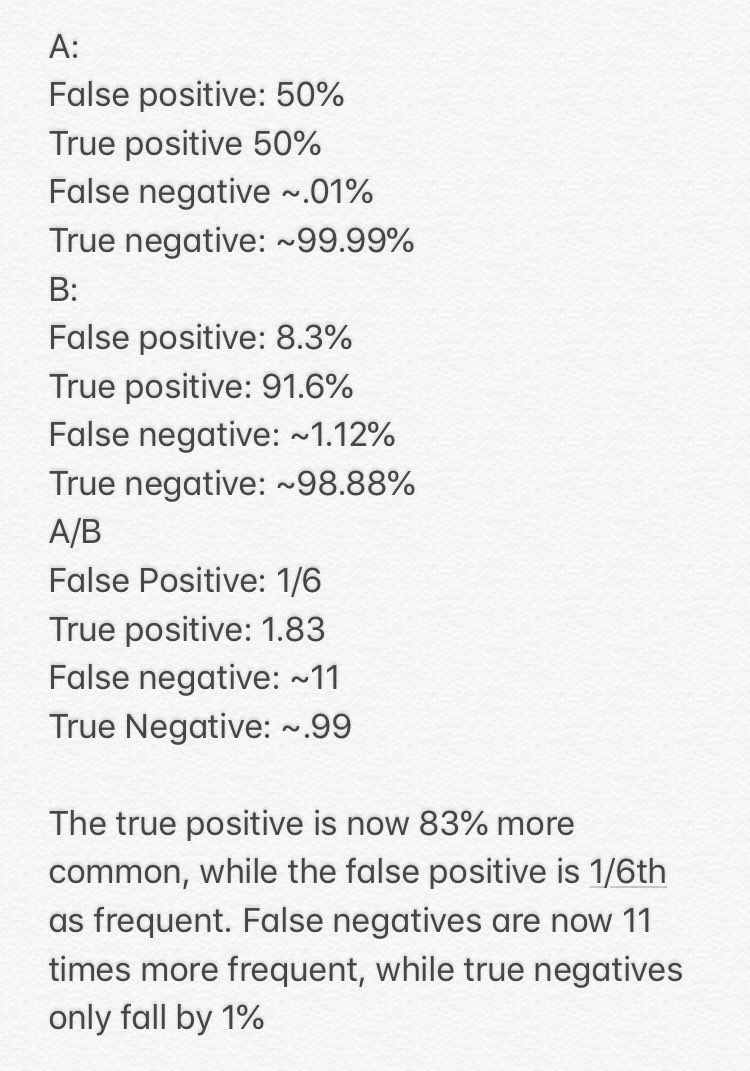I’m going to a very basic thread on criminology & statistics, to illustrate a point about why police & prisons suck so hard.
If a trait is very rare in population, then even a super accurate method of detection will produce false results. A positive result on a 99% accurate test for a disease found in 1% of the population, will be wrong half the time. https://sphweb.bumc.bu.edu/otlt/MPH-Modules/BS/BS704_Probability/BS704_Probability6.html
Baye’s theorem always trips me—as well as a lot of other people—up even tho the arithmetic is quite simple. A fact Alan Dershowitz famously used to his advantage http://www.stat.rutgers.edu/home/hcrane/Teaching/582/lectures/chapter5-Bayes.pdf
But bearing in mind the above caution, now let’s look at the math if the trait is found in 10% of the population. I get a mental block even just doing this basic stuff so forgive any errors, and just run it yourself.
For a very rare trait, if detection & treatment aren’t very costly or harmful,the best regime is to test & then treat for the positives. If the detection & treatment *are* costly & harmful, we’re in a bad situation, because now half the people treated will be harmed for no reason
The low rate of false negatives in the first case means that forgoing treatment with a negative result makes sense either way, but especially if it’s costly & harmful.
In the second case, again, with a low cost & low harm treatment it makes sense to treat. But even with a high cost, high harm treatment, it still makes sense to treat, because it’ll be relevant to most cases. BUT that harm will be magnified in the population substantially.
Of course, we have to weigh against how harmful the trait is, and how efficacious the treatment is—all of which will come back later. In the latter case, a low cost & harm treatment may make sense even where one tests negative bc it’s now much more likely it’s a false negative.
So we have to know the:
1. Rate in the population
2. The accuracy & precision of true & false
3. The costs & harms of detection
4. The costs & harms of treatment
5. The damages of the trait
6. The efficacy of the treatment
1. Rate in the population
2. The accuracy & precision of true & false
3. The costs & harms of detection
4. The costs & harms of treatment
5. The damages of the trait
6. The efficacy of the treatment
In a total treatment regime in the first case, the harm to the broader society will be minimal but half of the people harmed will have been harmed for no reason. In the latter case, the harms to society are much larger but also more likely to be accurate.
In the former case, those who forgo a treatment are less likely to be wrong, and the harm will be minimal to the society at large. In the latter case, the harms of forgoing rise to the society, but we’re less sure we should forgo it.
This, remember, was assuming an unproblematic, 99% accurate test, and straightforward known rates in the population with straightforward costs. This is the BEST case scenario, and everything is downhill from here. So keep that in mind.
We now see in the base case scenario, dealing with a rare trait will be highly innacurate & unjust, but less costly to society as a whole. While forgoing treatment is unproblematic.
In the latter case, while the treatment will be more accurate & just, the social harms are vastly higher, and, what’s more, the harms of forgoing it are also costlier, AND more innacurate. You may see where I am going with this.
If you assume only 1% of a society commits a crime, then even under best case scenarios, you’re going to falsely imprison half of them, and while you won’t do much broader harms, you’re still in a better bet if you don’t treat.
If we assume 10% of a society does it, then substantially more people who should have been punished won’t be, AND the costs to the society of punishment are horrendous.
In the former case, aggregate social costs are low, but half the people you jail are innocent, and you’re on a surer footing when you find someone not guilty than the reverse!
In the latter case, you still have, in my view, an unacceptable rate of innocents (8%—meanwhile 4% is a percentage bandied about as the maximally just rate , although it’s basically arbitrary), but that’s less the issue.
In the latter case, even when you’re accurate, the aggregate social costs of enforcing the punishment are enormous, and you’re also slightly less certain of found innocence.
This, remember, is the best case scenario but also remember:
1. We do not know the true rates in the population of crimes, and defining the true rate depends on incredibly variable social, cultural, and legal mores even within a society, let alone across all of them
1. We do not know the true rates in the population of crimes, and defining the true rate depends on incredibly variable social, cultural, and legal mores even within a society, let alone across all of them
2. Detection itself is incredibly costly & harmful, is always prejudiced, and spatial correlations with traits makes it intrinsically racist & classist even when there’s no intention to do so. This clustering effect doesn’t go away even if we abolish class etc
3. Detection is incredibly and inherently inaccurate, and is WEIGH less than 99%. It’s 90% clearance rates when the cops just frame innocent people. It’s a maximum of around 60% when they have a modicum of restraint. And that’s the highest case analyses.
4. Adjudication is similarly costly, innacurate & prejudiced
5. Punishment is absurdly costly, harmful, and unjust
6. The maximum rate of prediction of reoffebse is somewhere around 40%, & that’s where you include situational & structural variables i.e. re-marginalize people
5. Punishment is absurdly costly, harmful, and unjust
6. The maximum rate of prediction of reoffebse is somewhere around 40%, & that’s where you include situational & structural variables i.e. re-marginalize people
7. Detection & punishment are ineffective—not even including the shift of harms in to the prisons, or indirect harms, a 66% increase in imprisonment leads to a 3% fall in crime. While for individual offenders, imprisonment increases reoffense by 3-7%.
If one includes the effects of policing (instead of JUST punishment),then policing & prisons are criminogenic. If one includes the indirect effects of imprisonment,it is criminogenic. If one includes crimes in the prisons, they’re criminogenic. In short, punishment creates crime
What’s more, these trade offs work in a weird way, such that for the most heinous crimes in society, that are rare, there’s absurd rates of BOTH false positives (unjustly inprisoned), & false negatives (criminal getting away), & massive social harms.
This is the best case of the worst cases, because heinous crimes are going to be rarer, more pathological, higher standards of evidence, more cooperation, & so on.
Now, let’s consider another possibility—heinous but common crimes—by the strict non-leftist & clinical definition, the rate of any kind of abuse, misconduct, harm, and so on, is already somewhere between 1/12th & 1/6th.
For less extreme cases of the above, 1/6th is the floor and we’re talking more like 1/3rd. This is the *low* rate for the world. And the strictest clinical rates & definitions.
By the definitions I used on here, the most heinous category is something like 25% people st minimum—again that’s the low world rate, in some places it’s more like 50% as the floor—ranging to 50%.
For the less extreme, chronic, & pathological forms, by the definitions i see used here, 2/3rds is the floor, and in some cases it’s up to 90% or higher.
This is just for one broad meta class of harms. If we throw in murder, assault, violent theft, all forms of manipulation & abuse, exploitation, alienation, militarism, expropriation, policing, abuse of power, war, genocide, racism, and so on. We’re not in very good shape.
Indeed, for just this latter category we’re talking some 1/2-3/4ths for the global north, and some 1/4-1/2 elsewhere. Combining these two categories makes strict super-majorities in every country in the world who have done something heinous.
So, now we have a problem, even under the strictest, most universal definitions & clinical criteria, our best case scenario means a very high minimum rate of false imprisonments & unpunished harms. They trade off, as above, but there are floors & ceilings for both.
This is assuming best case detection—in reality detection is further limited. Even with a maximally resourced police force, total surveillance, and with a genie magically wishing away income inequality & prejudice, we’re still in a horrible situation.
We will combine the worst of all worlds—high cost of detection, adjudication & punishment, discriminatory, inaccurate, high harms of detection, adjudication & punishment, horrible reassessment of reoffense, tons of innocent people punished & tons of guilty walking free.
At the other end of the spectrum, we have nothing short of a total overhaul of the world. With, if we’re being optimistic, some 1/6th-1/3rd of the world in need of incarceration, with parole & probation for the rest.
If we’re being more honest one half of the world has to imprison the other hand. And in the zero tolerance, one strike you’re out, no cultural variation, broad left wing definition, 1/9th of the world has to imprison the other 9th.
Now, it gets even worse because detection, efficacy of punishment, cooperation, rehabilitation, deterrence, incapacitation, justice, accuracy, precision & cost all trade off with each other in intrinsic ways.
Going back to the first two examples, most people who saw the two examples would say that the second case, where 10% of people have it, a mass regime of screening, prevention, triage, & lifestyle changes would be the best bet. As with cancer, heart disease, smoking, etc.
In the former case, we deal with the issue of rare & harmful diseases. In our current world, these only even get detection & treatment regimes if they affect rich people. Even in an ideal socialist world there’d be teadeoffs.
So as for health, as for punishment. Except the difference is that punishment doesn’t even serve the ends it declares, it worsens the problem, is absurdly unequal & harmful, and is tantamount to torture (& ofc actual torture DOES occur).
There are a few ideal cases where one can have privacy, anonymity, autonomy & mobility, and also sociality, culture, useful occupation of time, & substantive resources. There are more cases where one gets one independent of the other. But mostly they trade off.
This is the famous liberty/equality trade off, the positive/negative rights trade off, the maximin problem, gesselschaft vs. gemeinschaft, mechanical vs. organic, etc. Cities grant you anonymity, mobility, & privacy, but you lose solidarity, community, sociality, & so on.
Pastoral, rural & ‘non modern/traditional’ life tends to have (or used to, even accounting for idealization) denser kin structures, fulfilling use of time, and so on, but very little privacy, mobility, & anonymity.
Prisons—even the idealized Swedish dorm room that leftists love—strip humans of their anonymity, privacy, autonomy & mobility, WITHOUT providing corresponding sociality, culture, useful use of time. They strip humans at both ends, their individual & social life alike.
In response to this people start to offer watered down versions, that start to look less & less like prisons as we imagine them, but which, nonetheless keep its key abuses—surveillance, immobility, constraint, lack of freedom & privacy, denial of autonomy, inequality & violence
So they eventually get to a point where they just give it up and describe something other than prison—a magical fairyland where people voluntarily surrender autonomy to be ‘corrected’ & protected, or they just admit the central conceit of prisons is harm.
Restorative justice, by contrast, reduces reoffense rates by around 7%, is absurdly less costly & less unequal, doesn’t rely on harm & violence, is a more accurate detection process, & falsely done harms are reversible.
But this is too soft for most people so let’s talk another book I think anyone who likes this stuff should read ‘In Defense of Flogging’ https://www.chronicle.com/article/in-defense-of-flogging/
As near as I can tell, this book is the most consistent, coherent & just defense of a carceral System I have ever encountered—it’s immediate, straightforward, known in advance, doesn’t deny people freedom, mobility, privacy & sociality, & false harms can be at least compensated
What’s more, because of its central conceit, it works far better as a case of speciak & general deterrence. The policy that, although liable to be abused, skews in favor of ‘punish first, compensate the falsely punished & punish those who abuse the system’, guarantees equity
In such a system, a rich person would merely have to be found with the preponderance of evidence to be punished, so we don’t have to worry about guilty but powerful people walking free.
What’s more, the system gets people’s desires—justice, proportionality, ‘nonviolent’ crimes aren’t punished, there’s retribution, revenge, punishment, & specific & general deterrence, there’s immediacy, accuracy & precision & a compensation mechanism.
People aren’t tortured by wiling away their lives forever in a prison. The publicity of it guarantees public shaming—and could even be mixed with restorative justice to create reintegrative shaming.
In order to effect incapacitation & rehabilitation would require additional aspects, but everything from public apologies, compensating victims, post-hoc sousveillance, & conditional rehabilitation, therapy, occupation & so on.
If you go through a ritual public apology & compensate your victim, you get a lesser Flogging. If you agree to undergo rehabilitation, you get a lesser Flogging, and you get flogged if you don’t keep up with it. That gets you restitution, rehabilitation & a form of incapacitation
What’s more, one gets incapacitation without putting prisoners in a situation where they will be abused, schooled in violence, learn tricks of the trade, strip their humanity, and harm other prisoners.
In sum, in such a configuration, one gets all the stated aims of punishment—retribution, justice, punishment, procedure, apology, restitution, special & general deterrence, incapacitation, compensation, due process, reintegrative shaming, & rehabilitation.
Indeed, one gets all of the benefits of a carceral System with few & in many cases none of the costs!—well that is, except that every week you’re taking human bodies to a public stockade & brutally searing the flesh from their body with a spiked stinging cane or lash.
But, hey, justice can’t have everything !
Best part is that it’s scalable—indeed, one can get take lashes off someone’s sentence if they lash someone else, and if they voluntarily surrender themselves—so all of the abuses & harms of the world, even if 90% of people do them, can be adjudicated in sequence !
Instead of he who is without sin cast the first stone—which incentivizes people to cast stones to prove they’re innocent—we take the opposite approach, *only* those who have sinned may punish.
Such a set up would be, as economists call it, incentive compatible—one is rewarded for surrendering to punishment, is punished for trying to defer it, AND as an added bonus, you get to hurt those evil fuckers conditional on getting your due first! What could go wrong?
By basically any standard, this combined public flogging + compensation, restoration, & rehabilitation regime, that incentivizes cooperation & admissions of guilt, is the idealized punishment system.
Of course, it could get abused by vindictive & spiteful people, especially if power structures are in place that enable people to frame & accuse people, but, again, bc punishment is conditional on being punished, this has a mechanism for self correction.
If someone gets you flogged for no reason, they get flogged (indeed you get to do the Flogging!) and you are compensated. Again, it’s incentive compatible!
What’s more, there’s no prison industrial complex, private prisons or police, no correctional officer or police unions, no drug prohibition profiteers, no ability for organized crime, terror & gang groups to co opt the system, and no profit in punishment.
As such, the incentive compatible Flogging with compensation, restoration, rehabilitation, and so on system, is THE IDEAL carceral & punitive system!
Despite my cheeky tone, I’d go as far to say that—with no hint of irony—if, as a reform measure, the entire world’s punishment systems were to be replaced by this system, I would endorse it wholeheartedly—it’s Pareto improving, kaldor hicks efficient, & more efficient & just
It also has another added benefit—once implemented & the prisons are dismantled, and people are forced to regularly confront the conceit of their punishment—which is to say, to participate in horrendous corporal brutality one of several outcomes will occur
1. Either they are unphased by it, and we all come to recognize that brutal punishment was everyone’s true desire all along, and/or become densisitized & even come to enjoy it, both of which, while unsavory, would nonetheless make the system work more efficiently OR
2. People will become horrified by what they see, disgusted at the true brutal terror it enacts, and, with the prisons already dismantled & too costly to rebuild, & there being no prison industrial complex to profit, will simply dismantle the punitive system all together
Either way, it’s a win win—everyone finally gets their idealized prison & punishment system which is vastly more just than our own, and would *at least* be effective, or we all become penal abolitionists & do away with it once and for all.
This proposal is, obviously, to most people horrendous, as corporal punishment is considered a thing of the past. Indeed, part of the conceit is precisely that, as it is straightforward, but by non emotional, logical reasoning, it’s clearly superior to our current system.
The system also lacks the systematic & intrinsic tradeoffs of the our current system—its uniformity, incentive compatibility & so on, means that it’s likely that someone punished by it actually did something worth punishing
It’s sequential nature means that guilty people going free is incredibly unlikely, AND that, even if punished while innocent, one is compensated, and doesn’t lose years of their life to a panopticonic torture machine crime university.
Since once is effectively rewarded for voluntarily undergoing it, the issue of the false positive is vastly less serious. And the issue of assessing reoffense rates doesn’t arise at all.
And this is my point, when 1 accounts for the intrinsic statistical, epistemic, procedural, equity, justice, accuracy, precision, cost, efficiency, efficacy, incentive compatibility, immediacy, & stigmatizing aspects of punishment, the Flogging regime is superior in all accounts
It fulfills the retributive, consequential, utilitarian, justice, procedural, shaming, reintegrative, restitutive, educative, spectacular, rehabilitative, deterrent, incapacitating aspects & aims of justice & prisons with few to none of its intrinsic costs & issues
And so, it forces us to come to grips with a simple fact: if a mass institutionalized regime of public flogging is the idealized, cost minimized version of our worldview, perhaps that worldview needs some re adjusting
Sly & critically thinking readers of this thread will notice something right away—a system of restorative, transformative, educative justice achieves all of the aims i said above, without, yknow, the Flogging part.
So I was actually being a bit dishonest—it’s not the idealized system, restorative & transformative justice are, except in one key way—the latter lacks the character of *retribution* & *punishment*
There are, therefore, to my mind, only two consistent views on this subject—either one should advocate the total dismantling & replacement with the aforementioned flogging system, or one should advocate total dismantling & replacement with restorative justice
If retribution & punishment are your aims, but you claim to be a leftist concerned for all the things I mentioned, only this Flogging System is consistent. If retribution & punishment truly aren’t your aim, then you need to address why you’re so averse to restorative justice?
So, I throw down the gauntlet here, and I truly sincerely believe this, if your aim isn’t prison abolition but you want to dismantle the oppressive aspects of our system, then you should demand an immediate & total replacement by this institutionalized flogging System

 Read on Twitter
Read on Twitter






